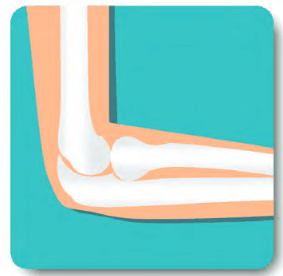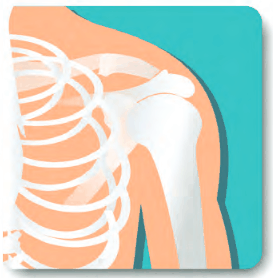Blog
Does Tiger Need A Coach?
Tiger Woods recently announced that, after three years, he is no longer working with his golf instructor Chris Como. Of course, with this type of decision, the public is ready to critique both the pros and cons. Tiger has been playing golf at a high level for a long time. He has had some of the top teachers in the world like Butch Harmon, Hank Haney, Sean Foley and Como. His longest lasting coach/student relationship was with Harmon, for almost seven years.
Between all of the instruction Tiger has had over the course of his lifetime, one would assume his knowledge and understanding of the golf swing in general – not to mention his golf swing – is very high. Tiger should be able to break down his swing, spot out areas to work on or tighten up. And if such is the case, then does he really need a coach telling him what he already knows?
I think this is a good move for Tiger. He can focus on scoring, working on shotmaking, scrambling and his short game. Tiger has always been the best scrambler the world has ever seen. Getting back to focusing on scoring, and not overthinking mechanics, could be just the thing he needs.
The great Ben Hogan always talked about “digging your swing out of the dirt.” You have to hit balls on the driving range to figure out what alterations you need to make. You need to play the shot shape you bring to the course and know your game. Only time will tell if Tiger is making the best move for his game. In my opinion, he is making a smart decision about his game.
Making The Most Of Taking Golf Lessons An Open Letter To Our Students
We hear very often how difficult golf is. There is no doubt that hitting a 1.68-inch ball with a flat surface on the end of a stick seems crazy. Add trees, water, weather, and worst of all, the human brain, and it can seem almost impossible. But there is something about golf that is even more difficult sometimes than the game itself, and that is the experience of taking instruction from another person on how to perform the difficult task of hitting a golf ball. So, how do you get the most out of golf instruction? There are several keys to maximizing the instruction you receive. First of all, let’s assume you are taking the lesson from a qualified, knowledgeable instructor. That is another subject; therefore, sticking with our objective, we will assume the person giving you the lesson is qualified to help you improve.
Let’s begin with the most important key to improving through lessons: start the lesson with an open mind. A common refrain for swinging a golf club, and this can apply to any sport, is the phrase “feel is not real.” What does that mean? Basically, what we think we are doing and our perception of the motion we are performing is far different than what we are actually doing. Therefore, understand your perception of reality is different than what the instructor is seeing. Allow the instructor to explain your issues and develop a plan of attack.
Understand that your current motion will feel “natural,” no matter how detrimental it may be to your success. Human beings are amazingly adaptable. We are built to learn, good or bad. Even the worst swings you see on the driving range feel great to that person performing it.
Communication. Instructors want to understand your goals, how you feel about any previous instruction, what you think about when you swing the club, or what you are trying to do when you practice. Some golfers are embarrassed, to be honest. Your instructor has most likely seen and heard it all, so there is no reason to hold back. If you have been working on a tip that you found on the Internet or something your friend told you, let the instructor know.
Ask questions. If you do not understand something, do not be shy or proud to tell the instructor. If you do not, they will assume you understand. Believe me, we love it when you ask questions. If nothing else, it gives us a chance to show how smart we are!
Video can be a great teaching tool. When an instructor shows you a video of your swing, pay close attention to what they are talking about and focus on their observations. Often, golfers are looking at what catches their eye and not what the instructor is pointing out. The untrained eye will see the symptoms; the trained eye will see the disease, or in other words, the systemic problem you have. Don’t get caught up in things the instructor doesn’t want you to think about. One thing I have learned after 45 years in golf, 33 professionally, is that no one likes the way their swing appears visually. We are all hyper-critical when watching ourselves on video – even tour players.
Do not forget to ask the instructor for a practice plan. Any good instructor is going to give you specifics on how they want you to practice. Just like a fitness routine or diet plan, follow the plan they give you. Do not, I repeat, do not stray off into the never-never land of golf tips. That will only slowdown your progress or even make you worse. At the same time, you wasted your money and time on the lesson by “chasing the secret.” Guess what? There is no secret.
Lastly, be patient. Unlearning and learning a physical motion takes time. Band-aids can produce temporary good shots, but you will be sacrificing long-term improvement. I have seen many examples of students that were ready to give up just before making a leap in their shot making and ball striking. The golf swing is a journey with no destination. Look at your lessons as another small step in the right direction. It just takes time.
Most of all, have fun and try to enjoy the learning process. Embrace and enjoy the practice and the challenge of improving. For many of us, the difficulty of golf is what made us fall in love with the game to begin with. Good luck!
Drills That Work
One of the hardest things for a student to accomplish is to take what you have been working on with them to the golf course. That’s why I think it is so important to give them a couple of drills that they can take with them to the course. Deciding which drill or drills that they can use will obviously depend on what you have been working on together on the practice tee.
Here are a couple of drills that I have found to be very beneficial. To be clear, the player must understand that he must have some swing thoughts, although it would be great to go out there and just swing. I think we all know that’s a pretty impossible exercise.
These two drills can be taken to the course and substituted for your regular practice swing. It will clear the head and help to promote a more beneficial, relaxed swing Have a swinging day!
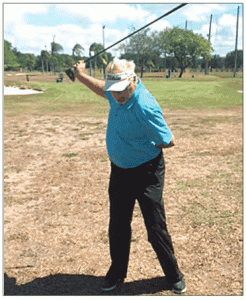
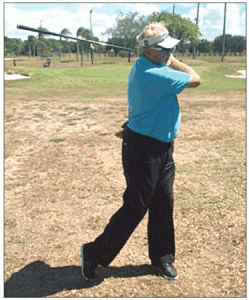
#1 Swing the club with one hand only, preferably with the right hand for a right-handed player. However, a couple of swings with the left hand only will not hurt. When you swing the club with the right hand only, you will feel the body movement better in regard to moving the lower body in the proper sequence. Start by swinging the club, holding the club at the shaft end closest to the head of the club. This will also help the student get the feeling of the club whipping and creating clubhead speed through the hitting zone after one or two swings. Then, reverse the club and swing one-handed, holding the club at the grip end. This exercise can be performed instead of a practice swing, so there will be no slowing of play.
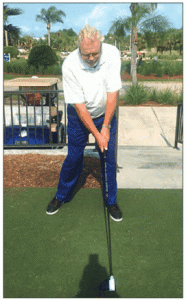
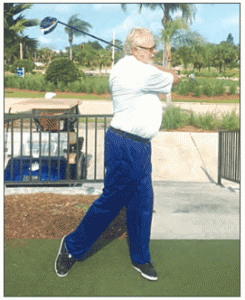
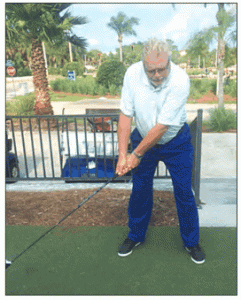 #2 Follow-through drill. As a practice swing, take the club about one-third of the way back. Take a little pause, then bring the club slowly into the impact zone, watching the club square up at impact, but now it is important to go through to a full-balanced finish position: belt buckle facing the target, left foot planted, right shoulder closest to the target, club behind the back with the arms folded in a classic follow-through position. I have found in my own swing, throughout the years, that if I could finish in a good position, the shot would be pretty good. Balance is everything in a golf swing, or in any other sport.
#2 Follow-through drill. As a practice swing, take the club about one-third of the way back. Take a little pause, then bring the club slowly into the impact zone, watching the club square up at impact, but now it is important to go through to a full-balanced finish position: belt buckle facing the target, left foot planted, right shoulder closest to the target, club behind the back with the arms folded in a classic follow-through position. I have found in my own swing, throughout the years, that if I could finish in a good position, the shot would be pretty good. Balance is everything in a golf swing, or in any other sport.
What Can You Learn from the New Masters Champion, Sergio Garcia
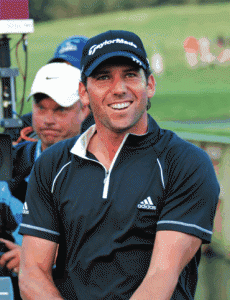 By Dr. Gregg Steinberg
USGTF Member and Sports Psychology Consultant, Nashville, Tennessee
By Dr. Gregg Steinberg
USGTF Member and Sports Psychology Consultant, Nashville, Tennessee
ACCEPTANCE – this was the key mental game ingredient that lifted the new Masters champion, Sergio Garcia, to victory.
In his younger days, Garcia would get upset when the bounces and breaks did not go his way. But as he matured as a person, Garcia stated that he learned to accept what Augusta National gives you and takes from you. This acceptance gave him peace of mind to handle the pressure and win his first major in 74 attempts.
Acceptance is key for any profession. There are always going to be bad weeks with a few bad breaks. But there will also be a turnaround with fortunate twists of fate. Life is full of peaks and valleys. The biggest problem is when we don’t accept an inevitable valley in our life.
When those downward patterns occur, some people lose their resolve. Others panic or begin to doubt themselves and lose faith in their abilities. Some people begin to overthink and believe their way of doing the job is completely wrong. In many cases, this negativity of thought turns into a nasty slump.
Be like Sergio Garcia. Accept the times when you are struggling and learn to go with the flow. Don’t start overanalyzing your strategies and lose confidence in your past successes. Behind every successful person are times of repeated failure and feelings of despair.
More than 150 years ago, Charles Dickens knew this to be the human condition when he wrote the memorable words, “It was the best of times, and it was the worst of times.” Your business life will cycle with many twists and turns. Don’t let a valley throw you off course. There is great wisdom in the principle of acceptance.
Topics such as acceptance to help you succeed can be found in the Emotional Toughness University online course (go to www.EmotionalToughnessUniversity.com). Please go to the site for your free emotional toughness e-book as well as free videos and articles.
(Dr. Steinberg is a professor of human performance at Austin Peay State University in Clarksville, Tennessee, and is also the USGTF’s longtime sports psychology consultant. This column is adapted from his Washington Post bestselling business book Full Throttle. Dr. Steinberg speaks to businesses about mental and emotional toughness. Email him at mentalrules24@msn.com or see www.DrGreggSteinberg.com.)
Students Finding Their Way With GPS
 Nowadays, it seems almost everyone has a GPS to navigate their way to their destination, and golfers are no exception. Students in and around Phoenix, Arizona (the Valley), have access to their own GPS when it comes to learning golf – Golf Program in Schools.
Nowadays, it seems almost everyone has a GPS to navigate their way to their destination, and golfers are no exception. Students in and around Phoenix, Arizona (the Valley), have access to their own GPS when it comes to learning golf – Golf Program in Schools.
USGTF Certified Golf Teaching Professional Larry Gantverg of Phoenix is involved in the program, and he says, “This excellent non-profit organization is bringing no-cost golf instruction to public schools as part of the school’s physical education pro-gram. The program takes five days, and in 175 minutes I am able to teach the pre-shot routine including grip, full-shot irons, full-shot drivers, as well as pitching and chipping. This instruction is accomplished using mats and rubber balls in the gym of the school.” Instruction is primarily geared towards students in the ninth grade, but has also been taught to those as young as in the sixth grade.
A similarity to The First Tee program is that GPS imparts character lessons to students involved in the program, named “PATH” – persistence, achievement, trustworthiness and health. It is a long-held belief among many golf teaching professionals that the game is a well-suited vehicle for imparting life lessons, and GPS takes advantage of that belief in using golf to do just that.
Part of the mission of GPS, in addition to introducing kids to golf, involves educating them in regard to golf-related careers, giving them a sport they can play for a lifetime, and informing them about available golf scholarships. According to its website, “GPS addresses so much more than just learning to play golf. By exposing students to the numerous opportunities for success, we intend to instill a positive vision. We want all students to develop their own unique talents and abilities and ‘find their way’ through life by making positive healthy choices.”
Gantverg, a USGTF member since 2014, is an enthusiastic advocate of the program, saying, “This excellent non-profit organization is bringing no-cost golf instruction to public schools as part of the school’s physical education program. I have a very unusual teaching method, using toys and tools which I call totems, representing aspects of the golf swing, thus allowing replication of exactly the same golf instruction by more than one teacher.” Gantverg is also a member of the advisory board of GPS.
GPS, a non-profit organization, is seeking volunteers to continue its mission. USGTF members who reside in the Valley and are interested in volunteering may find more information on the website www.GolfPS.org.
Three Questions That Capture Your Customer’s Attention
Editor’s note: As golf teaching professionals, we are also in the sales business. This article, while not specifically written for teaching professionals, is pertinent to our profession and provides valuable guidance for furthering your business.
You may be asking yourself, “Why didn’t I get the follow-up meeting with that recent prospect?” You asked all the right questions and got the answers you needed to qualify them. You had their budget, knew their goals and needs, and their time frame to make the decision. You knew who the decision maker was, were keenly aware of your competitors that were in play, and felt that you had the perfect solution to meet their needs.
So why didn’t it work out?
Unfortunately, this happens to many sales professionals, yet only one will earn the customer’s business. While you may be asking good questions, you may not be asking the right questions. You want to ask the type of questions that make the customer take notice of who you are and what you have to offer. What makes them pay attention to you? What are the questions that get the customer to say, “Tell me more”?
Customers get bored when you ask the basic surface questions. These are the questions that you need to have answered to better understand the customer’s situation and so that your solution can be positioned to meet the customer’s needs. Customers already know their situation. They want to know what makes you different from the pack, and how you can help them in a way that provides value that no one else can deliver. And remember, the last thing your prospects want on a first appointment is a presentation! This meeting is not about you and what you offer. It should be all about your customer and how you can help them meet and exceed their needs and achieve their goals and objectives. Customers want the conversation to be all about them. In other words, let them talk – you should be listening!
So what are the questions you should ask? Think about it this way: customers engage best when they are asked specific c and targeted questions that pique their interest and highlight the consequences of unsolved issues. There are three critical types of questions you need to ask to build momentum and ensure that you get the next meeting:
What are the issues? To build the critical trusting relationship, you need to understand what’s really going on. Ask them, “What issues are you facing that most need to be resolved?” Do not start by asking what type of solution they are looking for or how much they will spend; instead, aim to learn where they are experiencing pain. How bad is the pain and how long has it been going on? The best sales people dig deep when it comes to understanding customer issues. You can further understand the pain by asking “why” questions. When you ask “why,” you’re bringing the customer into the past which allows them to elaborate on what happened in the first place.
What is the cause? Ask them, “How long have you been having this issue? Is it getting better or worse? Do you have any thoughts on why?” These probing questions will demonstrate that you are truly interested in understanding their situation to the fullest extent. It means that you are building credibility with the customer and showing them that you care. This approach takes the conversation to a better level of understanding and often they will even discover something they hadn’t seen before. Helping your customers understand the cause of their issue helps you understand which solutions to offer – when appropriate – and helps them to think through the situation.
What is the impact? Impact questions help to create a sense of urgency about the issue. Now that you more fully understand the problem and how it was caused, it’s time to talk about the possible impact on the business. Ask them, “How do you think this issue is having an impact on productivity, customer service, revenues or operating expenses?” When you can help them understand the impact, they are one step closer to taking action in your direction. When the customer sees the impact of their issues in multiple areas, we can start to craft a viable solution. You can start to help them see the future in a positive light by asking “what” questions. “What” questions focus on the possibilities. Now you can work with customer as a partner since you have a solid understanding of their issues, how they came about and how their impacting the business.
Good selling is all about going below the surface by asking thoughtful, probing questions that help to uncover the key issues, the root causes, and finally the impact that their most painful issues can have on their business. As the saying goes, “If you ask better questions, you’ll get better answers.” The best sales professionals have great skill in asking the more significant thought-provoking questions that make a difference in the customer dialogue.
Prepare to ask questions that your customers will pay attention to and you will be much closer to building the kind of relationships that will lead to more closed sales. Good selling!
About the Author: Stu Schlackman is a sales expert, accomplished speaker and the author of Four People You Should Know and Don’t Just Stand There, Sell Something. With over 25 years of success in the sales landscape, Stu provides his clients and audiences with the wisdom, techniques and practical advice to compete and win in business and in life. For more information about Stu, please visit www.StuSchlackman.com.
Golf’s Five Major Body Problem Areas
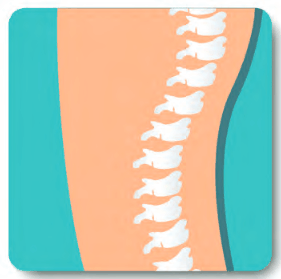 It is critical that golf instructors understand the five major body problem areas to prevent golf injuries, and be able to identify swing characteristics that can cause those injuries. The five areas that we will briefly y discuss in this article are the lower back, wrists, shoulder complex, elbow and hips.
It is critical that golf instructors understand the five major body problem areas to prevent golf injuries, and be able to identify swing characteristics that can cause those injuries. The five areas that we will briefly y discuss in this article are the lower back, wrists, shoulder complex, elbow and hips.
Consider this: A golfer exerts a compressive force of eight times their weight on the lower back with each swing. So, if you weigh 200 pounds, you exert a compressive force of 1,600 pounds on your lower back each time you swing. Compare that to running, which is considered a high-impact sport that normally produces a compression force of three to four times the body weight. Lower back injuries account for 36% of all golf injuries. Ouch!
Posture is a critical component of the golf setup and we should be on the lookout for incorrect posture such as C and S posture. C posture occurs when the shoulders and the thoracic spine (12 vertebrae in the upper back) are slumped forward at address. Take note of the round back, thus the descriptor – C posture. It is important because it leads to poor spine rotation, which in turn limits the ability to make a good backswing. S posture is characterized by excessive arch in the player’s lower back at setup. The player is literally sticking their tailbone out to create an S curvature of the spine, which places the body out of position on the downswing and will affect the swing sequencing. S posture is caused by a combination of tight hip flexors and a tight lower back paired with weak abs and glutes, whereas C posture is caused by weak deep-neck flexors and low/mid traps paired with tight upper trapezius and pectoralis major and minor muscles. Statistically, 64.3% of amateur golfers lose their posture, and yes, the same amount early extend. Approximately two-thirds of those tested at the Titleist Performance Institute showed signs of posture breakdown: 25.3% had S Posture and 33.1% had C posture.
The wrists are a delicate part of the body that can be injured most often when a player hits a fat shot. Strengthening the wrists is critical to the golf swing to prevent loss of clubhead speed and prevent further injury. Once the wrists are injured, each and every swing will send vibrations down the shaft to the wrists, which slows the healing process. A wrist flexion and extension test can measure how much the player can fl ex their wrist downward or upward. We would like to see a flex of 60+ degrees of mobility. You can use a 6-iron (which has a lie angle of approximately 60 degrees) as tool to measure the player’s ability to fl ex the wrist. Use the angle of the iron to measure the angle of flex. Anything less than 60 degrees is a sign of boney and/or muscle mechanic problems. Common swing faults associated with this limitation are casting and over the top.
Let’s move on to the shoulder complex, where we see 75% of the injuries are to the lead shoulder. Very large ranges of motion in swing plane create an unstable joint that relies on soft tissue for stability. There are 20 muscles in the shoulder complex that deserve attention to avoid muscle imbalances. Poor flexibility leads to reverse spine angle, loss of posture, a flat shoulder plane and or early extension.
The elbow is also an area that creates problems for golfers. Causes include gripping the club too tightly, or altering the grip during the swing, which generates excessive forearm musculature forces. Swing flaws to watch for: The chicken-wing on the follow-through and early casting of the club in the downswing can cause tissue damage. It must be identified and corrected.
The last major problem area is the hips. We all know that hip rotation is essential to produce an efficient golf swing. Lack of rotation is caused by poor strength and flexibility conditioning, which can exert unnatural forces to produce a technically inefficient golf swing. Asking the hips to move with additional force to produce greater clubhead speed will stress the muscles, ligaments, tendons and joints. A seated trunk rotation test will help you identify thoracic spine, muscular and myofascial as well as cervical spine mobility restrictions.
Please Google the different tests listed in this article on YouTube for fuller explanation, and suggested exercises to enhance the golf swing.

